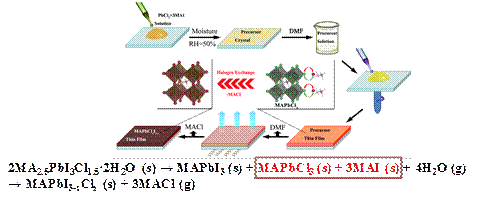| Aquointermediate Assisted Highly Orientated Perovskite |
| From: PublishDate:2017-06-16 Hits: |
Thin film solar cells have advantages of small weight, thin thickness, flexible, low preparation cost and would have a broad market. As an excellent representative of thin film solar cells, perovskite solar cells (PSCs) shave been setting off a new revolution of science and technology in the photovoltaic field. Traditional polycrystalline perovskite film has the disadvantages, e.g., high defect density, low mobility and poor structure stability etc, which affects the thermal stability of the PSCs device and photoelectric conversion performance. The research groups innovationally synthetize high orientation hydrate precursor crystals (MA2.5PbI3Cl1.5·2H2O), which induce the high orientation of perovskite membrane, and then the PSCs photovoltaic properties are studied. The two-dimensional orientation precursor of hydrate crystals are prepared via mixing PbI2 and MAI precursor in moist air. The hydrate precursor crystals induce stress-free residual perovskite films in the heat process. PSCs based on the thin film device perform much more stable than that of traditional film in the process of 70 oC thermal test. The perovskite films prepared with this method has high crystallinity, high orientation along < 110 > and < 220 > crystal direction and less defect density. Based on the high quality films, the PSCs device efficiency reaches 16.9%.
Schematic view of the crystal growth process of highly orientated MAPbI3–xClx perovskite thin films. In the traditional one-step method, PbI2 is one of the intermediate product in the process. The reaction between MAI and PbI2 leads to the larger lattice expansion, lower crystallization of the crystal, and more residual stress inside thin film. Herein, hydrate precursor crystals could generate high crystalline intermediate MAPbCl3 in the annealing process, which could halogen exchange with MAI and produce MAPbI3-xClx perovskite. In this process, the crystal lattice distortion is negligible. The results from BSRF further show that the new film has no obvious stress residual. The study by inducing hydrate precursor growth, gets the higher thermal stability of perovskite film and perovskite solar cell device, which provides a new method for the fabrication of high crystal quality perovskite film. The corresponding results were published in Advanced Energy Materials, 2017, 7(2), 1601433。
Article: Wenzhe Li, Jiandong Fan,* Yaohua Mai, and Liduo Wang*, Aquointermediate Assisted Highly Orientated Perovskite Thin Films toward Thermally Stable and Efficient Solar Cells. Adv. Energy Mater. 2016, 1601433. |
|
|
| Chinese
- Metal-free efficient photocatalyst for stable visible water splitting——Top ten major scientific progresses in China in 2015
- The nano-resolution imaging platform was awarded the first rate prize of Beijing Science and Technology in 2014
- Beamline 1W1 of BSRF started to runoperate in the couplingparasitic mode of BEPCII
- Synthesis of High Performance Polymer Materials for Field Effect-Transistors
- Surfactant molecular aggregates in green solvents
- GIXRD has played an important role in the characterization of organic thin-film transistors
Science Highlights
Home /
Copyright © 2011 - 2012 Beijing Synchrotron Radiation Facility


